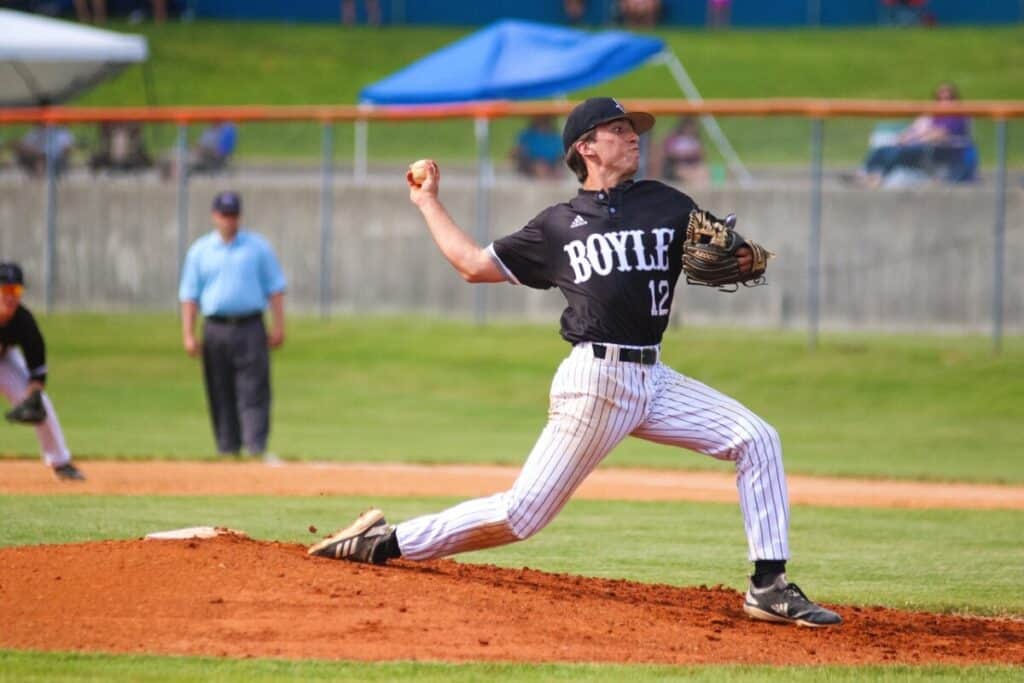What Is a Walk Off Home Run in Baseball

During the course of a nine-inning baseball game, each team can easily throw over 100 pitches. Even though each team throws a lot of pitches, batters only swing at a limited number of pitches. Sometimes the reason a player takes a pitch is obvious, but sometimes it seems like the batter is intentionally letting a ball go by for a strike. Why do baseball players take a pitch?
As a general rule, baseball players take a pitch because they don't like what the pitcher threw or because their team is implementing a strategy where it's beneficial for the player to take a pitch.
Each player gets three strikes when it's their turn to bat and good hitters know how to use the count to their advantage. From my experience playing baseball, there are a handful of reasons why a player would take a pitch in baseball, so let's dive into the 11 reasons why a baseball player would take a pitch.
#1) Not a Good Pitch To Swing At

Not all pitches are the same and not all hitters are the same. Good hitters know where their sweet spot is in terms of what pitches they like and where they like those pitches to be located.
Whenever a hitter has less than two strikes, they can be pickier about what pitches they swing at. Even if they see a pitch they know is a strike, they don't have to swing if they don't believe it's a good pitch for them to hit.
Ted Williams, known for being one of the best hitters in baseball, is known for being a great hitter by being patient and waiting for a pitch he knew he could hit. Whenever he had less than two strikes, he would only swing at pitches that were located within his hitting zone.
#2) Pitcher is Not Throwing Strikes

On occasion, pitchers have an off-day. There are numerous reasons why a pitcher might be having a bad day on the mound, but smart hitters know the best way to get on base is to force the pitcher to throw strikes when that pitcher is having a tough time locating the strike zone.
By taking pitches, hitters are forcing the pitcher to throw more often. And if the opposing pitcher is having an off-day, there is a better chance the hitter will walk or put themselves into hitters count, which will give them a better chance to hit a base knock.
In some leagues, especially youth leagues, coaches will ask their team to not swing the bat until they have one strike in the count. This strategy is used by coaches when they notice the opposing pitcher is having difficulty throwing strikes.
By having every player on a team take every pitch until there is one strike in the count, the coach is forcing the opposing pitcher to throw more pitches, which could lead to more baserunners for the team.
#3) Players Don't Swing on a 3-0 Count
One of the many unwritten rules of baseball is that hitters should take a pitch on a 3-0 count. Other than a 3-0 count being an unwritten rule, there are also plenty of other reasons a hitter would prefer to not swing on a 3-0 count.
One benefit to not swinging on a 3-0 count is that the umpire may simply call the next pitch a ball and the batter is awarded first base. The more baserunners a team has, the better their chances are of scoring a run.
Another benefit of taking a 3-0 pitch is that it forces the pitcher to throw more pitches. In general, the more pitches a pitcher throws, the more likely they are to make a mistake on the mound or even be replaced by a relief pitcher.
One last benefit to not swinging on a 3-0 pitch is that the hitter will not commit an out. If the hitter were to swing on that 3-0 pitch, there's a chance they would have hit into an out instead of taking the pitch and possibly walking to first.
Even though there are benefits to taking a 3-0 pitch, there are a handful of occasions where a hitter may want to swing on a 3-0 count. Learn more about when a player should swing on a 3-0 count from another one of my articles.
#4) Allow Teammates to See What Pitches a Pitcher Can Throw

When it's early in the game and your team is facing a pitcher you've never seen before, you can get a lot of benefit from watching that pitcher before it's your turn to bat.
When hitters take pitches, they give their teammates a chance to study the opposing pitcher. The more pitches they can get the pitcher to throw, the more likely that pitcher will show what breaking pitches they have.
In addition to seeing what breaking pitches an opposing pitcher can throw, teammates can also study the pitcher to see what their delivery looks like and how fast that pitcher throws.
When players take pitches during their at–bat, their teammates can reap the benefits. Ideally, the more pitches a player sees, the better their chances are of getting a base hit.
#5) Hitter Expected a Different Pitch
Sometimes, an at-bat has the ability to turn into a mental game. The hitter tries to guess what the pitcher will throw next and the pitcher is trying to throw something the hitter isn't expecting.
When a hitter is expecting one type of pitch, but the pitcher throws another type of pitch, hitters will generally take a pitch (as long as there are not two strikes in the count).
Hitters have an advantage if they are able to correctly anticipate a pitch and if they have less than two strikes, there is no harm in taking a pitch they are not expecting.
I know from experience that when a hitter swings at a pitch they are not expecting, it is a lot less likely the ball will be hit hard and a lot less likely the hitter will safely make it to first base. Hitters can get lucky on occasion from swinging at a pitch they are not ready for, but it is generally best practice to swing at the pitch you're expecting.
#6) Allow a Teammate to Steal
One of the best offensive strategies to get a runner into scoring position is allowing a baserunner to steal. Stealing a base is already a difficult task to accomplish, but the one thing that makes it more difficult and more frustrating is seeing a teammate steal and seeing the batter hit a foul ball.
Whenever a batter is waiting for the pitch and they notice one of their teammates is stealing, they often opt to take a pitch. As long as the batter doesn't have two strikes in the count, they can afford to take a strike. And as an added bonus, they will have their teammate in scoring position if that teammate is safe on their steal attempt.
The one time where a batter would not opt to take a pitch during a steal is if they are trying for a hit-and-run. During a hit-and-run, the base runner will steal and the batter will swing and try to put the ball in play.
#7) Umpire Has a Tight Strike Zone
There is a lot about the game of baseball that varies from game to game and one of those things is how big the umpire's strike zone is. At the Major League level the strike zone is fairly consistent, but at other levels of baseball, the umpire behind the plate can have a big impact on how the game goes.
During the games where an umpire has a tight strike zone, players may opt to take more pitches than they swing at because umpires are more likely to call a ball on pitches that are close to being a strike.
When an umpire has a tight strike zone, it also allows the hitter to be pickier about which pitches they decide to swing at. They know the pitch needs to be closer to the middle of the plate so they know they have a better chance at making solid contact when they swing at a strike.
#8) Increase the Pitch Count of the Opposing Pitcher
A general consensus in baseball is that it is easier to score off of relief pitchers than it is to score off of starting pitchers. This is because starting pitchers are typically better pitchers than relief pitchers.
One strategy to get the defense to bring in a relief pitcher earlier in a game is to take pitches. Each batter gets 4 balls and 3 strikes in each plate appearance so each batter has some leeway to take pitches and increase the pitch count of the opposing pitcher.
If enough players on a team take pitches and increase the opposing pitcher's pitch count, it is more likely a relief pitcher will be needed.
#9) Strategy For When Your Team is Down by a Lot of Runs

Major League baseball may not have a need to have a strategy for taking pitches when they are down by a lot of runs, but taking pitches when your team is down by a lot of runs is a common strategy in non-professional baseball leagues.
In Little League, it was a common strategy for our team to take pitches until one strike was called on us whenever we were down by a lot of runs. This strategy was in place to force the opposing pitcher to throw us strikes.
In youth baseball leagues, it's common for pitchers to struggle with throwing strikes so some coaches will ask their team to wait to swing until they have one strike in the count. The goal is to get as many baserunners as possible and close the gap in runs.
On the other hand, some coaches are not a fan of this strategy because they would rather their players get experience swinging the bat. So whether or not a team takes pitches until they receive a strike depends a lot on how the coach views this strategy.
#10) Player Prefers to Take a Pitch
A common saying in baseball is that "it only takes one", which means that hitters only need to connect with one pitch and it's ok if they got a strike or two in their at-bat. Because it only takes one pitch for a hitter to get a base hit and because each hitter gets up to three strikes during their turn to bat, some players develop a habit of taking the first pitch.
Taking the first pitch is not a common habit, but it is something that I still see while playing in adult baseball leagues.
For some players, taking the first pitch of their at-bat is a way for them to get their timing down, while other players just feel more comfortable in the batter's box after they've seen one pitch.
Either way, each hitter gets three strikes and if a hitter feels more comfortable taking the first pitch then they still have two more strikes to work with.
#11) Hitters Can Afford to Take a Strike
There could be numerous additional reasons why a player would take a pitch, but if a hitter has less than two strikes in the count then they can simply afford to take a strike.
Some additional reasons to take a strike could include the hitter being caught off-guard by the type of pitch that was thrown, the hitter thinking about bunting the ball and pulling the bat back at the last second, and the hitter changing their mind about swinging after seeing the pitch and thinking it will break out of the strike zone.
When it comes down to it, hitters can be more aggressive at the plate when there are less than two strikes in the count. If they see something about a pitch they don't like, they can afford to let that pitch go.
What Is a Walk Off Home Run in Baseball
Source: https://baseballtrainingworld.com/11-reasons-players-take-a-pitch-in-baseball/


Komentar
Posting Komentar